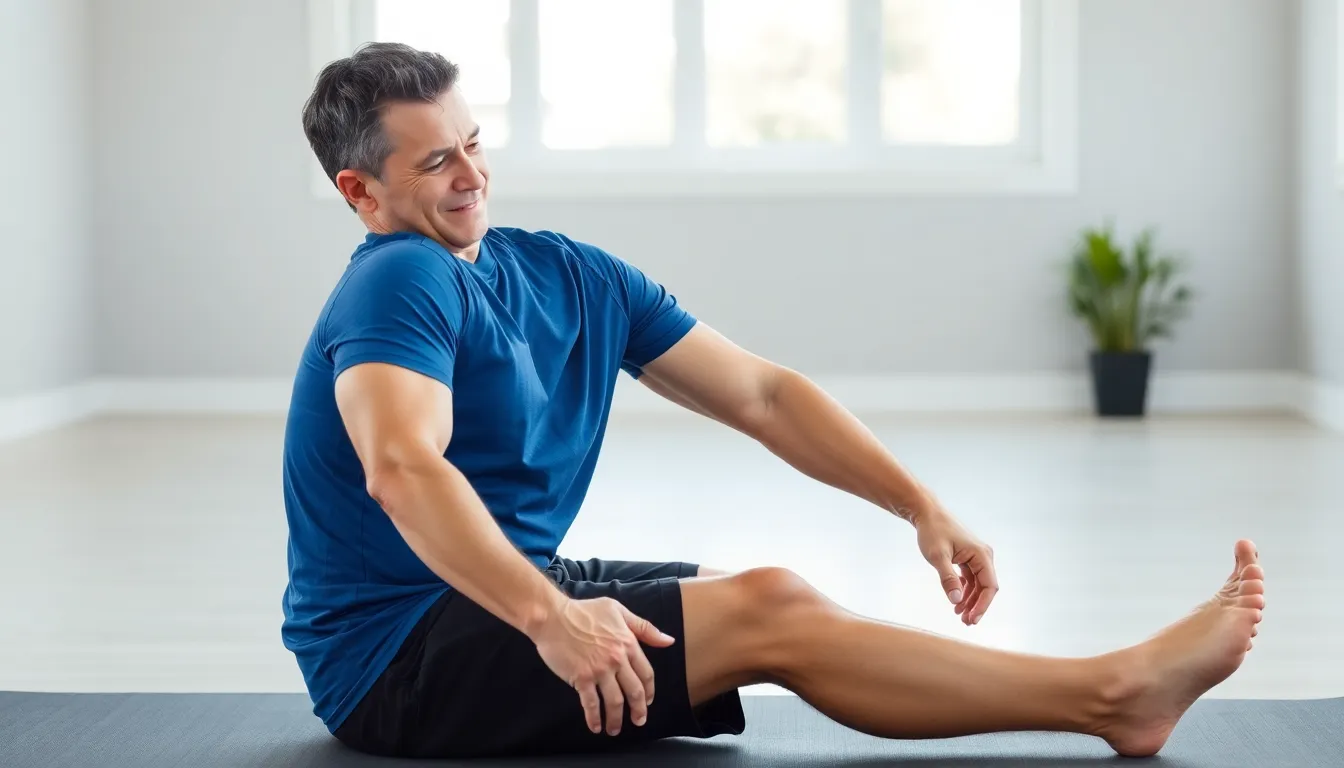A meniscus tear can feel like a cruel joke played by your own knee. One minute you’re sprinting like a gazelle and the next, you’re sidelined, wondering how a simple twist could turn your life upside down. But don’t worry; it’s not the end of your athletic aspirations. With the right exercises, he or she can bounce back stronger than ever—like a superhero in a knee brace.
Meniscus tear exercises aren’t just about rehab; they’re about reclaiming your freedom. These targeted movements help strengthen the muscles around the knee, improve flexibility, and reduce pain. So, whether it’s getting back to the gym or simply conquering the stairs without a wince, a solid routine can make all the difference. Let’s dive into the world of knee-friendly workouts that’ll have you feeling like your old self again—minus the awkward limping.
Table of Contents
ToggleUnderstanding Meniscus Tears
Meniscus tears frequently afflict individuals involved in sports and physical activity. Recognizing the underlying aspects of these injuries aids in effective recovery.
What Is a Meniscus Tear?
A meniscus tear involves a rip in the cartilage that cushions the knee joint. This structure acts as a shock absorber, distributing weight during movement. Tears can vary in type, with vertical, horizontal, and complex being the most common. Injuries may range from minor tears that cause minimal pain to severe tears that significantly hinder knee function. The severity often influences treatment options and recovery time.
Common Causes and Symptoms
Meniscus tears typically arise from activities that involve twisting or turning, such as football, basketball, and sudden pivoting. Age plays a role too, as degeneration often increases the risk. Symptoms may include pain on the inner or outer knee, swelling, and difficulty in bending or straightening the leg. A popping sensation at the time of the injury is also common. It’s important to seek medical evaluation for persistent symptoms to ensure proper diagnosis and treatment.
Importance of Rehabilitation

Rehabilitation plays a crucial role in recovering from a meniscus tear. Strengthening the knee and restoring mobility helps prevent further injuries.
Benefits of Meniscus Tear Exercises
Improved joint stability results from targeted meniscus tear exercises. Enhanced flexibility also leads to better range of motion. Reduced pain occurs when muscles around the knee strengthen, supporting the joint effectively. Increased strength allows individuals to return to sports and physical activities more confidently. Engaging in these exercises may also promote faster recovery, reducing overall rehabilitation time.
When to Start Exercising
Starting exercises promptly is vital, but it requires caution. Medical professionals often recommend beginning rehabilitation as soon as pain subsides. Individuals may initiate gentle exercises like range of motion and stretching within a few days post-injury. They should progress to strengthening exercises after assessing symptom management, typically within 4 to 6 weeks. Monitoring pain levels while exercising helps ensure a safe and effective recovery process.
Types of Meniscus Tear Exercises
Meniscus tear exercises focus on rehabilitation, aiming to strengthen the knee and improve mobility. The following exercise types play a vital role in recovery.
Gentle Stretching Exercises
Gentle stretching exercises promote flexibility and reduce tension in the muscles surrounding the knee. Basic stretches include the seated hamstring stretch and the calf stretch. Patients perform the seated hamstring stretch by sitting with one leg extended, gently reaching toward the toes. The calf stretch involves standing near a wall, placing one foot behind the other, and bending the front knee while keeping the back heel on the ground. Holding each stretch for 15 to 30 seconds allows the muscles to relax and gain additional flexibility.
Strengthening Exercises
Strengthening exercises help rebuild muscle around the knee, enhancing stability and support. Notable exercises include straight leg raises and wall sits. In a straight leg raise, an individual lies on their back with one knee bent and the other leg straight, lifting the straight leg to the height of the bent knee and holding for a few seconds. Wall sits involve sliding down a wall into a seated position, ensuring knees stay above the ankles for stability. Engaging in these exercises two to three times per week promotes strength and function.
Balance and Stability Exercises
Balance and stability exercises enhance coordination and prevent future injuries. Simple exercises, such as single-leg stands and balance board workouts, serve this purpose well. During a single-leg stand, an individual balances on one leg for as long as possible, gradually increasing the duration. Incorporating balance boards into routines challenges core stability, forcing the body to stabilize on an unstable surface. Performing these exercises regularly fosters improved balance and stability, which are essential components of overall knee health.
Tips for Effective Exercise
Effective exercise plays a crucial role in recovering from a meniscus tear. Prioritizing proper techniques and listening to the body ensures a safer rehabilitation process.
Proper Warm-Up Techniques
Implementing proper warm-up techniques significantly enhances workout effectiveness. Begin with low-impact activities, such as walking or cycling, for 5 to 10 minutes to increase blood flow to the knee. Engaging in dynamic stretches, including leg swings and hip circles, aids in preparing the muscles and joints for upcoming exercises. Focusing on gradual movements promotes stability and reduces the risk of injury. Including specific movements that target the knee area ensures a tailored approach, encouraging optimal results. Consistent warm-ups set a solid foundation for more intense rehabilitation exercises.
Listening to Your Body
Listening to the body remains essential during the recovery journey. Paying close attention to any signs of discomfort guides individuals in adjusting their routines accordingly. If pain occurs, modifying or pausing specific exercises can prevent further damage. Prioritizing rest when needed allows the body to heal and rejuvenate. Understanding that everyone’s recovery pace differs encourages patience and persistence. Regular check-ins with physical therapists or doctors provide additional insight, ensuring exercises align with personal recovery goals. Establishing open communication regarding any concerns fosters a supportive rehabilitation environment.
Recovering from a meniscus tear is a journey that requires patience and dedication. Engaging in the right exercises can significantly enhance recovery and help individuals regain their strength and mobility. By focusing on flexibility and stability, they can not only alleviate pain but also prevent future injuries.
Listening to one’s body and adjusting routines as needed is crucial during this process. With the right approach and support, returning to pre-injury activities is entirely achievable. Prioritizing knee health through consistent exercise will empower individuals to stay active and enjoy their favorite sports once again.



